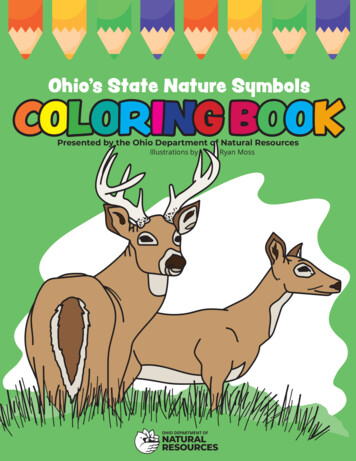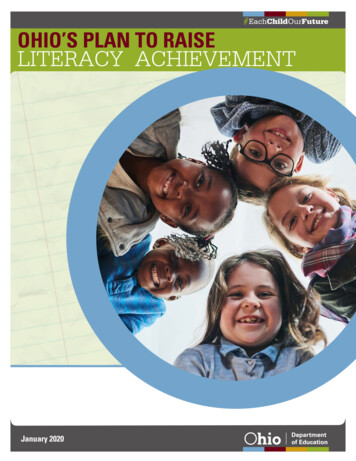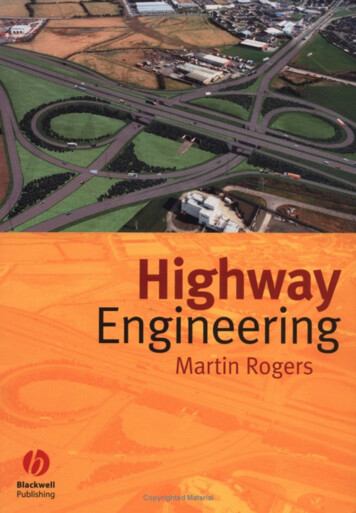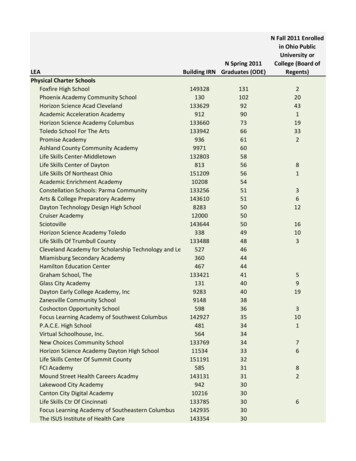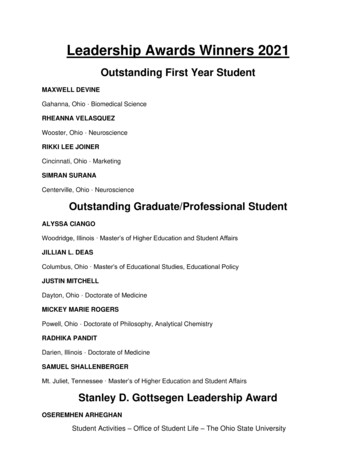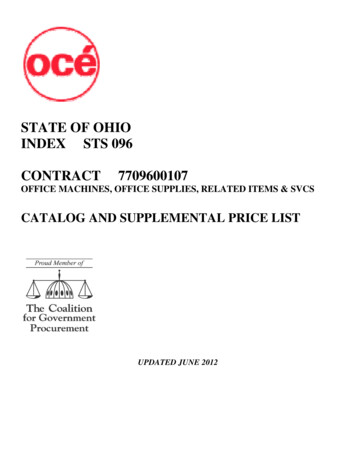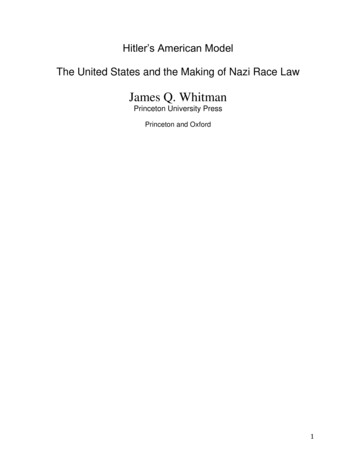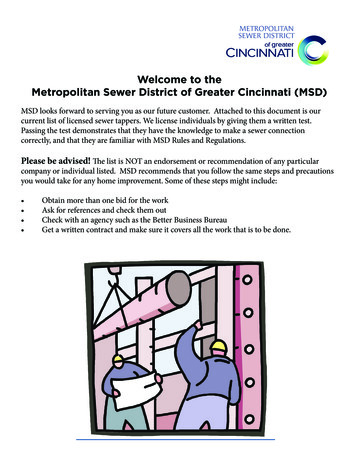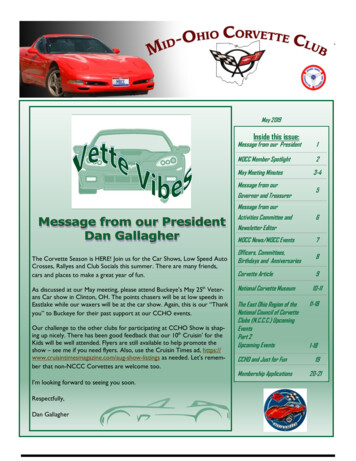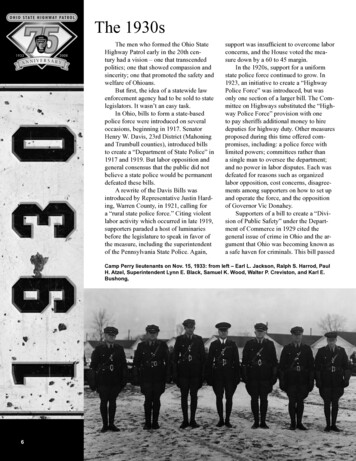
Transcription
The 1930sThe men who formed the Ohio StateHighway Patrol early in the 20th century had a vision – one that transcendedpolitics; one that showed compassion andsincerity; one that promoted the safety andwelfare of Ohioans.But first, the idea of a statewide lawenforcement agency had to be sold to statelegislators. It wasn’t an easy task.In Ohio, bills to form a state-basedpolice force were introduced on severaloccasions, beginning in 1917. SenatorHenry W. Davis, 23rd District (Mahoningand Trumbull counties), introduced billsto create a “Department of State Police” in1917 and 1919. But labor opposition andgeneral consensus that the public did notbelieve a state police would be permanentdefeated these bills.A rewrite of the Davis Bills wasintroduced by Representative Justin Harding, Warren County, in 1921, calling fora “rural state police force.” Citing violentlabor activity which occurred in late 1919,supporters paraded a host of luminariesbefore the legislature to speak in favor ofthe measure, including the superintendentof the Pennsylvania State Police. Again,support was insufficient to overcome laborconcerns, and the House voted the measure down by a 60 to 45 margin.In the 1920s, support for a uniformstate police force continued to grow. In1923, an initiative to create a “HighwayPolice Force” was introduced, but wasonly one section of a larger bill. The Committee on Highways substituted the “Highway Police Force” provision with oneto pay sheriffs additional money to hiredeputies for highway duty. Other measuresproposed during this time offered compromises, including: a police force withlimited powers; committees rather thana single man to oversee the department;and no power in labor disputes. Each wasdefeated for reasons such as organizedlabor opposition, cost concerns, disagreements among supporters on how to set upand operate the force, and the oppositionof Governor Vic Donahey.Supporters of a bill to create a “Division of Public Safety” under the Department of Commerce in 1929 cited thegeneral issue of crime in Ohio and the argument that Ohio was becoming known asa safe haven for criminals. This bill passedCamp Perry lieutenants on Nov. 15, 1933: from left – Earl L. Jackson, Ralph S. Harrod, PaulH. Atzel, Superintendent Lynn E. Black, Samuel K. Wood, Walter P. Creviston, and Karl E.Bushong,6
Pennsylvania State Police and Camp Perry InstructorLt. James Marshall steers the motorcycle, whileOhio Department of Highways Director O.W. Merrellaccompanies him in the sidecar in 1933.the Senate, but died in the House. Another bill calling forthe formation of a “safety police” was introduced in 1931,but it died in committee due to the cost.With each failure to create a uniform state policingauthority, support was substantially increased. An increasingly mobile society was becoming more than traditionallaw enforcement could keep up with, especially in thearea of traffic control. The reelection of Governor GeorgeWhite and sweeping Democratic victories throughout thestate were read as a mandate for major changes. The support of Governor White for a state law enforcement agencymade the creation of such a force inevitable.In 1933, the 90th General Assembly considered theBill which eventually created the Ohio State HighwayPatrol. Introduced by Representative Hugh A. McNamee,Cuyahoga County, HB 270 outlined a highway patrolwhich would enforce: state laws relating to registrationand licensing of motor vehicles; laws relating to motorvehicle use and operation on the highways; and all laws forthe protection of highways. Very important to the passageof the bill was a provision prohibiting use of the Patrol inlabor disputes and strikes. The bill also stipulated that theforce would be limited to 60 officers who were betweenthe ages of 24 and 40 years and placed under a 2,500performance bond.After years of failed bills, legislators finally passedHB 270 in 1933, creating Ohio’s first statewide policingbureau. One month later, the Ohio Senate also approvedthe bill creating the Highway Patrol. Governor Whitesigned the measure that same day with a June 30 effectivedate. Opponents of the Patrol proposed a referendum tonullify the bill creating the Patrol, but it was struck downon a technicality by the Ohio Supreme Court on September20, 1933.The two State Department of Highways employeesworking behind the scenes and inside the legislative hallswere O.W. “Whitey” Merrell and Harry Neal. Merrellwould, in 1931, become director of the highway department and Neal the traffic bureau director.Merrell, who many retirees refer to as the “granddaddy” of the Patrol, knew how to make things happen.It was he who made possible the purchase of radio equipment, the building of barracks at Findlay, Massillon,Wilmington and Cambridge, and the coordination of earlytraining facilities. Merrell’s background included toughnegotiation and hard work in highway contracting, but hewas known to relax while playing piano in the evening,according to William Newton’s newspaper editorial. “Hesmokes constantly, drinks little, and suffers from a trickystomach, which he babies with bicarbonate of soda,” the1930s article states.Merrell graduated with a degree in engineering from The Ohio State University and spent sometime as a plumber’s apprentice. “Sensitive about hisreal name – Otho Walter – he has his friends call him‘Whitey,’ or ‘Spider,’ a name he was given when, as aColonel Lynn E. Black stands in front of a very earlyPatrol vehicle – a mobile emergency radio vehicle – withunidentified local official, circa 1938.7
plumber’s apprentice, he asked to climb inside huge boilers,” the article states.Neal took responsibility for badge design. He assignedthe task to Mr. Joseph Goldberg, an engineer in Neal’sSafety Department. The “Flying Wheel” badge design,partially inspired by a study of others, originally was Goldberg’s idea. “What was important was to think up a simpledesign that would fit conveniently on a shoulder patch andsignify every thing pertaining to the Patrol,” Goldberg saidin a 1983 interview.Goldberg’s solution was to combine the wings of theRoman god Mercury, to denote speed, with the wheel, torepresent traffic law enforcement. But Neal’s reaction tothe design was lukewarm. “He kept asking me if thosewere the wings of a duck or the wings of an eagle,” Goldberg said.Goldberg also designed the Patrol’s badge, with an eagle for freedom on the top, the State Capitol dome below,the state seal in the center and a staff of rods on each side.In 50 years, the only change in the badge was to replacethe word “patrolman” with “trooper” when the first womanjoined the Patrol’s sworn ranks in 1977.Both Neal and Merrell worked diligently with Governor George White to create the new law enforcementagency. Their vision was to create an organization thatwould keep state highways safe and curb growing ruralcrime rates.Despite the time it took to get things started, Merrelland Neal were confident the Patrol would survive any obstacles. In fact, they already had Goldberg at work on theinsignia and badge design, and also had selected uniformsand equipment, set a training agenda, selected statewideoperational base locations, and identified a possible superintendent.Still, many administrative issues remained unaddressed, and Merrell and Neal knew they needed someone immediately. They chose six-year Highway Department employee, Fred “Fritz” Moritz (who later becamethe Division’s third superintendent) to serve as assistantsuperintendent. Moritz, who had distinguished himself asa talented administrator and knowledgeable in legislativematters, was endorsed by Neal for his conspicuous concernfor traffic safety, and as an “inside man” to watch over thenew department.Captain Lynn E. Black was Merrell’s choice for heading up the Patrol. Merrell’s policy of courteous and fairtreatment of the public meshed well with Black’s emphasison motorist assistance. Black and Merrell also felt stronglythat the Patrol remain free from political influence. Theirgoal was to create a policing agency that would treateveryone fairly and equally, and not let influence or affluence allow some people better treatment than others.Founding FathersIt took persuasion, but O.W. “Whitey” Merrellconvinced the Ohio Supreme Court to open the wayfor 60 men to patrol the highways and enforce stateregistration and vehicle operation laws.In 1933, Ohio state legislators passed a measureto create the Patrol, and a companion bill to transferthe Bureau of Motor Vehicles to the State HighwayDepartment.Even so, a proposal to nullify both bills gatheredenough signatures to make it to the November ballot,but was halted by the Ohio State Supreme Court on atechnicality – that both bills were considered on onepetition. The Court issued a decision to bar the referendum, clearing the way for the Patrol’s formation.Interviews with Patrol retirees state that Merrell8Ohio Department of Highways Director O.W. Merrelllooks on during the opening ceremony of anotherPatrol barracks.faced opposition to establishing a state highway patrol from local law enforcement and union members.
Patrolmen inspect a commercial vehicle, including itsweight, making sure it doesn’t exceed highway limits.Black’s sterling reputation as the leader of the Cincinnati-area based Indian Hill Rangers was widely known.The Rangers, created by a group of wealthy families toguard their neighborhood, still exist and are a regularpolice force today. Black’s efforts caught the attention ofSheriff Asa Butterfield of Hamilton County, and in 1931,Many believed the sheriff system worked just fineand that a state police would only create territorialconflicts. But for others – many others – the increasing use of motor vehicles on state highways and thelack of police enforcement in rural areas necessitateda statewide agency.Newspaper reports of the time state that Merrellannounced that Hamilton County Police Captain LynnBlack would be head of the Patrol only an hour afterthe court handed down its decision to bar the referendum, which allowed for the formation of the Patrol.“It will be six weeks to two months before we getthe men recruited, trained, and out on the road,” Merrell said in one newspaper interview. “Black will goto work at once.”Merrell had no other person in mind other thanBlack for the job; Merrell admired Black’s work inBlack accepted a position as a captain in the HamiltonCounty Sheriff’s Office.It was Black who led the way for future patrolmen atthe First School, also known as the Camp Perry School,which opened October 3, 1933. Black went through morethan 5,000 applications and interviewed nearly 300 mento narrow the recruits down to a group of about 125 tocomprise that first training class. The cadets had their workcut out for them, as few had motorcycle experience and thePatrol just purchased 53 Indian motorcycles and one fromHarley-Davidson. It is thought by some retired Patrol officers that motorcycles were more economical than cars atthe time, thus the reason for purchasing the bikes.For training, the Ohio National Guard volunteeredCamp Perry, located on the shores of Lake Erie. It wasvery difficult to train due to frigid temperatures and a lackof heaters in the barracks. In fact, severe weather in November 1933 shortened the training.Different sources give different numbers for how manyentered training at Camp Perry. The most reliable figure is112; several men left after the first day of training. Only60 graduated as patrolmen – the limit imposed by state law- with 15 others serving as “weighmen” until patrolmanpositions opened, according to the graduation photo takenand information from Patrol personnel documents.Many did not make it through graduation for severalHamilton County. “Whitey” also liked Black’s leadership qualities and the no-nonsense approach to lawenforcement. Black was known by cadets and patrolmen as strict, but fair.“(Black) was a very strict disciplinarian,” saidRetired Patrolman John Evans in a 2002 interview.“And he made a big name for himself at the Cincinnati Indian Hill Rangers that he formed and he was agood superintendent, a very good superintendent.”Evans said Black’s leadership was complex, butfascinating. “He had his idiosyncrasies. He didn’twant anybody to stay stationed very long until theywould be moved to another station because he didn’twant them to make friends. And that’s been changed.”Evans also pointed out proudly that “I don’tthink politics had practically anything to do with thepatrol.”9
reasons. Not withstanding the cold, studies were not easy,and many men could not handle the strict military discipline incorporated into the training.Although there was no money allocated by the statefor classes, a curriculum was developed, covering everything from how to shoot a gun properly from differentpositions to how to operate a motorcycle. Black was themain instructor, but the training staff included: Moritz;Pennsylvania State Police Lt. James Marshall and Sgt.Herman Roush; Dr. H.E. Stricker, first aid; and JamesDavis, a motorcycle racing champion who provided ridinginstruction.Despite the difficult conditions, silly antics often prevailed at the camp, brought on by the camaraderie amongstcadets. One time, when Cadet George Mingle (who laterbecame colonel) went on “extra duty” for violating regulations, he was assigned to clean one of the camp’s twolatrines as punishment. He was amazed at how many menused the latrine to which he was assigned, but, upon looking into the matter, discovered the cadet assigned to cleanthe other latrine had crafted an “out of order – use otherlatrine” sign.On November 15, 1933, a cold, windy, snowy day,Ottawa County Probate Judge P.W. Gulau administered theoath of office for 54 “safety conservators,” or patrolmen,six lieutenants, and Capt. Black, according to informationfrom a November 16, 1933, article from the ClevelandPress. The new officers then scattered immediately to theirassigned posts.The life of a Patrol officer was not easy in those days.There were many physical conditions to be met, and theywere paid 100 a month - plus room and board. Patrolmenwere required to live in barracks at the local sub-stations– away from their families. They worked six days a weekand much more than 40 hours a week, according to formerpatrolmen; they were on-call 24 hours a day, with only a20-day furlough per year available, subject to the superintendent’s approval.People in communities opened up their homes to thepatrolmen, renting the Patrol space for each sub-post,which usually consisted of a simple room with a desk,some equipment, and a couple of cots for men to sleep.Oftentimes, homeowners cooked meals for the patrolmen,and filled in as dispatcher when needed.The First ClassIt may have seemed like a great job and the 112or so cadets were hand-picked by Colonel Lynn Blackfrom more than 5,000 applicants, but training atCamp Perry, located in Ottawa County, just was notwhat they thought it was going to be.The State of Ohio, in approving the formation ofthe Patrol in 1933, neglected (for many years, in fact,until it was evident the Division was up and going)to provide funding for training in the state budget.Therefore, when the Ohio National Guard offereduse of the grounds at Camp Perry, State Director ofHighways O.W. Merrell gladly accepted.At the time, Camp Perry had minimal accommodations - unheated barracks and a large mess hall. Thecamp, established in 1906 as an Ohio National GuardMilitary Training Site, was named after CommodoreOliver Hazard Perry, who defeated British forces inthe Battle of Lake Erie during the War of 1812. Thesite became and remains to this day a popular shoot-10Camp Perry Men Fred R. Collins and Thomas W.Thomas in their cold weather gear at Camp Perryin 1933 before heading out to their posts.
Some men saw the Patrol life as solitary comfort,while others resented not being able to live with theirfamilies or the long hours. By the end of 1934, half of theCamp Perry graduates had resigned. Ten training classeswere held between 1933 and 1938 to combat the resignations as well as to meet increases in manpower approvedby the state legislature.In a 2002 interview, retired Patrolman John Evanscompared his experience working for the Patrol to today’stroopers. Evans graduated with the Sixth Academy Classin Delaware on April 12, 1934.“To the best of my knowledge, they work eight hoursa day now and have for several years. When I was on thePatrol, we worked. We started off with 60 patrolmen tocover the state of Ohio and many times I would work 12to 14 hours, get back to the station, and go to bed. ThenI’d get another phone call and another accident happenedand I’d go out again and be gone for another several hours.That went on consistently where we would work for verylong hours. They don’t do that anymore.”Evans recalled his time operating a motorcycle whenhe began the Patrol.ing range; National Rifle Association Rifle and PistolChampionships have gone on there since 1907.When the First Class began training in October1933, winter came on strong and cadets froze in theunheated barracks. According to an article in the October 12, 1933, issue of the Lynchburg (Ohio) News,“The established routine begins with breakfast from 7to 7:30 o’clock in the morning, followed by exerciseand two classes before lunch at noon. In the afternoonthe regiment includes two other classes, with supper at5:30 p.m. Lights must be out in the camp at 10 p.m.”It was so cold, the two months planned for training turned into one month.One Camp Perry account is documented by theone of the first commissioned officers of the Patroland later, the first Patrol pilot, Capt. Ernest Webb, inhis autobiographical book, “On Eagle’s Wings.”“Our barracks were in old military bunk houses,no glass in the windows, but wooden shutters. Therewas a small cooking range for heat. This was a below“I drove a motorcycle then. We did not arrest forspeeding. Colonel Black was against calling it speeding. Itwas reckless operation. That’s what you had to put on thereport. You just observed as you were riding along on yourmotorcycle, like somebody passing another car and crossing a yellow line and taking the wrong lane on a curve. Ihad only had one bad occasion like that I was in a Patrolcar by myself and I came to a pretty sharp right turn andhere come a car and I pulled off to the bank that went upfrom the highway as far as could get and I still got hit.”When remembering his daily routine and the types ofcalls he had, Evans recalled a couple of incidents.“Three times I was riding a motorcycle and I was runoff the road into the ditch or the berm by an approachingcar passing another car,” he said. “Three times that happened to me and I arrested all three of them. If we arrestedsomebody, we’d wait until we got somebody there witha car. We would have to ask somebody to make a phonecall for us to the Highway Garage. They’d send out a car.If it was necessary that we had to put them in a jail, thegarage would send out a car and take in the person. Now,if it’s just a case of writing a ticket, there is nothing in-normal cold fall. We had problems keeping warm,the snow would blow through the windows and pileup on our blankets and clothes. We used layers ofpaper under the mattresses and between our two issued blankets. The last two weeks we were there, thetemperature was down near zero degrees.‘This did not stop our outside activities, such ascalisthenics at 6:00 a.m. every day, military drill, jogging one mile each way to the mess hall, three timesa day, motorcycle practice in deep sand and ridingacross canals on a two-foot wide walkway with norailings. Pistol practice everyday and classroom workuntil 10:00 p.m. at night.”Driving motorcycles on the way to assigned barracks after graduation was not much better accordingto Webb.“Our first stop was a gas station to get newspapers. We padded our trousers and under our shirts,anything to keep the cold out. A makeshift scarfprotected our faces.”11
A patrolman provides a motorist with enough gasoline to get to the next stop.volved there except writing a ticket and it can be an arrestticket or a warrant ticket.”“At this time, the patrolmen were not allowed to liveat home. We got two days off a month, 100 and meals.Through my association with the Governor, he changedthis to higher pay, and all married patrolmen could live athome,” Evans said. “Throughout his second term as governor, he pushed bills through the legislature for the betterment of the Patrol.”Patrolmen looked very different in those days. Apatrolman dressed in puttees, caps, helmet and goggles,leather coat, breeches, boots and drove a motorcycle. Notmuch equipment would fit on the motorcycles, either – afire extinguisher, first aid kit, and later a one-way radio.There were only white males in the force at the time,and entering information took time – using pen andtypewriter. General Order Number Seven was 10 pages ofinstructions detailing how early patrolmen were to fill outeach and every section of their daily report.In December 1935, when HB 569, the driver’s licenselaw, was passed to become effective in October 1936, legislators passed on to the Patrol a new responsibility. Whileadministered by the Bureau of Motor Vehicles, the actualresponsibility of testing drivers to obtain driver licensesfell onto the Patrol and local police agencies. When thelaw finally went into effect, the Patrol handled about onehalf of the examinations, primarily in rural communities.General Headquarters was located on the eighth floorof the state office building on South Front Street in Columbus. Six districts existed, each with its own headquartersand three subposts:District A Toledo — Defiance, Findlay, BellevueGear issued to patrolmen in the early years of the Division was sparse, but practical.12District B Ravenna – Medina, Salem, GenevaDistrict C Sidney — Middletown, Lima, Springfield
District D Delaware — Marion, Mansfield, NewarkDistrict E Cambridge — New Philadelphia, Marietta,BridgeportDistrict F Chillicothe — Wilmington, Portsmouth,Athens.A flood of “General Orders” came from general headquarters in those early days, attempting to clarify policiesand establish procedures. Most of the orders covered thetransfers of men, but others had more lasting significance.For instance, General Order Number Two (12-4-33) reduced the number of days off from four to two, an actionhardly popular but necessary in light of the small numberof men. It was around this time that Captain Black took onthe rank of Colonel.Change was the constant within the organization.Black’s belief that no one should stay in the same area forvery long was practiced thoroughly – many men went frompost to post in a matter of months. Black believed that being “too familiar” would be difficult for patrolmen, especially if they gave a citation to a family member or friend.There would be the temptation, he thought, to overlookinfractions.Terrible floods occurred in January of 1937, when theOhio River crested 20 feet above flood level in Cincinnati,and engulfed much of southern and eastern Ohio. Becauseof the enormous impact of the flood, Colonel Black temporarily suspended the Sixth Academy’s classes in January,and told the 22 cadets to report to southern Ohio. Patrolunits withdrew from the flood zone in early February andSixth Class Cadets returned to school in Findlay, wherethey graduated in March. According to The CincinnatiEnquirer, an estimated 100,000 people were left homelessin river towns stretching from Pittsburgh to Cairo, Illinois.There were 385 people killed and property losses went past 500 million.One result of the flooding was a statewide flood13
Cadets training on motorcycles at the Ohio State Fairgrounds in 1935.Information compiled from “The Harley-Davidsonand Indian Wars” by Allan Girdler and facts fromthe American Motorcyclist Association (AMA).Not many people live to be older than 100, andeven fewer can profess to be able to continue doingwhat they love beyond a century.The late motorcyclist Jim Davis did both.Davis is one of the pioneers of motorcycling’s“glory days.” The Patrol knows him from his workfor 14 years teaching cadets at training camps how toride motorcycles.Born and raised in Columbus, Ohio, Davis wonthe first AMA sanctioned race in 1924, and the AMAinducted Davis into the Motorcycle Hall of Fame in1998 for his years of racing and teaching.It all started in 1908, when Davis was 12 yearsold. He asked his dad for a motorcycle. “There werefive or six other kids in my neighborhood with motorcycles, which still had pedals on them, and we werealways racing each other,” Davis said in an AMAarticle posted on the group’s website. “I won thefirst official race I entered and won a pair of rubbergoggles and a quart of oil. I was on top of the world.”In 1915, Davis was at his neighborhood Indiandealership when Frank Weschler, head of sales forIndian, came to visit. The owner of the dealership in-14troduced Davis and told Weschler of the 19-year-old’sracing exploits. A few weeks later the dealer calledDavis into the dealership. Davis was surprised andthrilled to find a brand-new, eight-valve closed-portIndian factory racer with his name on it.By 1916, Davis was on the Indian factory team.This was in the days of brakeless racing machinesthat ran locked in gear with the throttle wide open, onbanked board speedways that allowed lap speed of120 miles per hour. Jim Davis clearly was a man ofskill and bravery. Not to mention nerve.“Early in 1920,” Davis recalled 75 years later,“I went to Phoenix with two bikes. The referee saidI couldn’t ride, that there was a new rule and they’dalready picked the riders.” Professional racing at thetime was controlled by a trade group, heavily backedby the major manufacturers and deeply political.Davis knew this.“I said, ‘If A.B. Coffman (head of the sanctioningbody) says I can ride, can I ride?’” They said yes, ifthey got a telegram. So I went downtown and persuaded the girl to send a telegram saying I could rideand signed by A.B. Coffman. I rode, won the event,and got the money.”But Davis’ telegram stunt did not go unnoticed.“When I got back to Los Angeles, the refereethere, who was a friend of mine, said I couldn’t ride.
Cpl. Floyd C. Moon is wearing a “blue-black” uniformshirt and Stetson hat. The Patrol changed from wearingcaps to the Stetsons sometime in 1939.trol’s motorcycles, which required skills not everyone possessed. The first Patrol class started with 112members, but only 60 graduated. While many factorscontributed to the high wash-out rate, a number ofrecruits failed to earn their commissions because theycould not master the art of motorcycle riding, evenunder the expert tutelage of Davis.When the first class of patrolmen broke camp inNovember 1933, the Patrol owned 53 Indian motorcycles and one Harley Davidson. Additional HarleyDavidson motorcycles were purchased in 1938, andby 1939, the Patrol owned 93 motorcycles and 91patrol cars. However, the benefits of patrol cars overmotorcycles - increased safety; more room for firstaid and other equipment; room for a two-way radio- convinced the Division to retire motorcycles alltogether in 1955.After leaving the Patrol, Davis went to work forhis family’s architectural business and became anofficial for the AMA. He received the AMA’s DudleyPerkins Award, the highest honor given by the association, for his life-long contributions to the sport ofmotorcycling. He became a celebrity in the later yearsof his life. He frequently spoke at gatherings of motorcyclists, entertaining crowds with humorous talesof his life and times in racing. Davis remained sharpto the end. He died on February 5, 2000, in DaytonaBeach, Florida. He was 103.I asked why not and he said he didn’t know, but he’djust gotten a letter saying I was suspended one year. Aweek or so later, the Harley team manager, Bill Ottoway, asked if I’d like to ride a Harley. I said sure, butI’m suspended. A week later, I was back racing.”How’d that happen?“The Harley factory did it. They supported theassociation, and I guess they just put on the pressure,”the AMA article states.Davis raced for Harley-Davidson until 1925.Indian re-hired him for the 1926 season and he immediately rewarded the company by winning threenational titles that year on both board tracks and dirtovals. Davis’ biggest season was in 1928, when hewon six national titles and was named the overallAMA national champion, a feat he repeated in 1929.Davis won his final AMA national at Syracuse, NewYork, in 1930 before retiring from his motorcycle racing career five years later.Colonel Black hired Davis in 1933 (before hisretirement, according to AMA archives) to teach cadets to ride motorcycles. Davis worked for the Patrolfor 14 years and taught the members of the first four Motorcycle training was difficult for some cadets.Famed motorcyclist Jim Davis was brought in to teachAcademy Classes how to operate and ride the Pathem.15
stage evacuation mapping system, developed by Lt. JohnKrichbaum. This not only would help future tragedies byallowing an orderly, controlled evacuation, but also servedas groundwork for post-World War II preparedness plansorganized by the Division in the 1940s.Later that year, on September 27, tragedy directlystruck the Division in the loss of Patrolman George A.Conn of the New Philadelphia Post. Conn was not thefirst patrolman to die on duty – there had been five killedbefore; four in car or motorcycle crashes and one waselectrocuted. However, Conn was the first Patrol officer tobe shot and killed.Conn left his post that day to serve a warrant to a manfrom Freeport who failed to appear in court. According toan October 3, 1937, Sunday Star (Columbus) article:16“At 7:45 Tuesday morning, Officer Hall at the NewPhiladelphia barracks reported to Cambridge that hisbuddy, Conn, had not slept in his bed. Lt. Bouten immediately checked with the
the state seal in the center and a staff of rods on each side. In 50 years, the only change in the badge was to replace the word “patrolman” with “trooper” when the first woman joined the Patrol’s sworn ranks in 1977. Both Neal and Merrell worked diligently with Gov-ern
